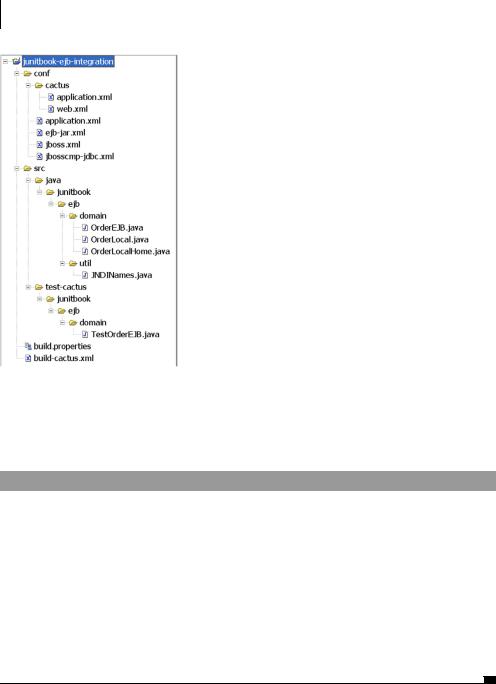
- •contents
- •preface
- •acknowledgments
- •about this book
- •Special features
- •Best practices
- •Design patterns in action
- •Software directory
- •Roadmap
- •Part 1: JUnit distilled
- •Part 2: Testing strategies
- •Part 3: Testing components
- •Code
- •References
- •Author online
- •about the authors
- •about the title
- •about the cover illustration
- •JUnit jumpstart
- •1.1 Proving it works
- •1.2 Starting from scratch
- •1.3 Understanding unit testing frameworks
- •1.4 Setting up JUnit
- •1.5 Testing with JUnit
- •1.6 Summary
- •2.1 Exploring core JUnit
- •2.2 Launching tests with test runners
- •2.2.1 Selecting a test runner
- •2.2.2 Defining your own test runner
- •2.3 Composing tests with TestSuite
- •2.3.1 Running the automatic suite
- •2.3.2 Rolling your own test suite
- •2.4 Collecting parameters with TestResult
- •2.5 Observing results with TestListener
- •2.6 Working with TestCase
- •2.6.1 Managing resources with a fixture
- •2.6.2 Creating unit test methods
- •2.7 Stepping through TestCalculator
- •2.7.1 Creating a TestSuite
- •2.7.2 Creating a TestResult
- •2.7.3 Executing the test methods
- •2.7.4 Reviewing the full JUnit life cycle
- •2.8 Summary
- •3.1 Introducing the controller component
- •3.1.1 Designing the interfaces
- •3.1.2 Implementing the base classes
- •3.2 Let’s test it!
- •3.2.1 Testing the DefaultController
- •3.2.2 Adding a handler
- •3.2.3 Processing a request
- •3.2.4 Improving testProcessRequest
- •3.3 Testing exception-handling
- •3.3.1 Simulating exceptional conditions
- •3.3.2 Testing for exceptions
- •3.4 Setting up a project for testing
- •3.5 Summary
- •4.1 The need for unit tests
- •4.1.1 Allowing greater test coverage
- •4.1.2 Enabling teamwork
- •4.1.3 Preventing regression and limiting debugging
- •4.1.4 Enabling refactoring
- •4.1.5 Improving implementation design
- •4.1.6 Serving as developer documentation
- •4.1.7 Having fun
- •4.2 Different kinds of tests
- •4.2.1 The four flavors of software tests
- •4.2.2 The three flavors of unit tests
- •4.3 Determining how good tests are
- •4.3.1 Measuring test coverage
- •4.3.2 Generating test coverage reports
- •4.3.3 Testing interactions
- •4.4 Test-Driven Development
- •4.4.1 Tweaking the cycle
- •4.5 Testing in the development cycle
- •4.6 Summary
- •5.1 A day in the life
- •5.2 Running tests from Ant
- •5.2.1 Ant, indispensable Ant
- •5.2.2 Ant targets, projects, properties, and tasks
- •5.2.3 The javac task
- •5.2.4 The JUnit task
- •5.2.5 Putting Ant to the task
- •5.2.6 Pretty printing with JUnitReport
- •5.2.7 Automatically finding the tests to run
- •5.3 Running tests from Maven
- •5.3.2 Configuring Maven for a project
- •5.3.3 Executing JUnit tests with Maven
- •5.3.4 Handling dependent jars with Maven
- •5.4 Running tests from Eclipse
- •5.4.1 Creating an Eclipse project
- •5.4.2 Running JUnit tests in Eclipse
- •5.5 Summary
- •6.1 Introducing stubs
- •6.2 Practicing on an HTTP connection sample
- •6.2.1 Choosing a stubbing solution
- •6.2.2 Using Jetty as an embedded server
- •6.3 Stubbing the web server’s resources
- •6.3.1 Setting up the first stub test
- •6.3.2 Testing for failure conditions
- •6.3.3 Reviewing the first stub test
- •6.4 Stubbing the connection
- •6.4.1 Producing a custom URL protocol handler
- •6.4.2 Creating a JDK HttpURLConnection stub
- •6.4.3 Running the test
- •6.5 Summary
- •7.1 Introducing mock objects
- •7.2 Mock tasting: a simple example
- •7.3 Using mock objects as a refactoring technique
- •7.3.1 Easy refactoring
- •7.3.2 Allowing more flexible code
- •7.4 Practicing on an HTTP connection sample
- •7.4.1 Defining the mock object
- •7.4.2 Testing a sample method
- •7.4.3 Try #1: easy method refactoring technique
- •7.4.4 Try #2: refactoring by using a class factory
- •7.5 Using mocks as Trojan horses
- •7.6 Deciding when to use mock objects
- •7.7 Summary
- •8.1 The problem with unit-testing components
- •8.2 Testing components using mock objects
- •8.2.1 Testing the servlet sample using EasyMock
- •8.2.2 Pros and cons of using mock objects to test components
- •8.3 What are integration unit tests?
- •8.4 Introducing Cactus
- •8.5 Testing components using Cactus
- •8.5.1 Running Cactus tests
- •8.5.2 Executing the tests using Cactus/Jetty integration
- •8.6 How Cactus works
- •8.6.2 Stepping through a test
- •8.7 Summary
- •9.1 Presenting the Administration application
- •9.2 Writing servlet tests with Cactus
- •9.2.1 Designing the first test
- •9.2.2 Using Maven to run Cactus tests
- •9.2.3 Finishing the Cactus servlet tests
- •9.3 Testing servlets with mock objects
- •9.3.1 Writing a test using DynaMocks and DynaBeans
- •9.3.2 Finishing the DynaMock tests
- •9.4 Writing filter tests with Cactus
- •9.4.1 Testing the filter with a SELECT query
- •9.4.2 Testing the filter for other query types
- •9.4.3 Running the Cactus filter tests with Maven
- •9.5 When to use Cactus, and when to use mock objects
- •9.6 Summary
- •10.1 Revisiting the Administration application
- •10.2 What is JSP unit testing?
- •10.3 Unit-testing a JSP in isolation with Cactus
- •10.3.1 Executing a JSP with SQL results data
- •10.3.2 Writing the Cactus test
- •10.3.3 Executing Cactus JSP tests with Maven
- •10.4 Unit-testing taglibs with Cactus
- •10.4.1 Defining a custom tag
- •10.4.2 Testing the custom tag
- •10.5 Unit-testing taglibs with mock objects
- •10.5.1 Introducing MockMaker and installing its Eclipse plugin
- •10.5.2 Using MockMaker to generate mocks from classes
- •10.6 When to use mock objects and when to use Cactus
- •10.7 Summary
- •Unit-testing database applications
- •11.1 Introduction to unit-testing databases
- •11.2 Testing business logic in isolation from the database
- •11.2.1 Implementing a database access layer interface
- •11.2.2 Setting up a mock database interface layer
- •11.2.3 Mocking the database interface layer
- •11.3 Testing persistence code in isolation from the database
- •11.3.1 Testing the execute method
- •11.3.2 Using expectations to verify state
- •11.4 Writing database integration unit tests
- •11.4.1 Filling the requirements for database integration tests
- •11.4.2 Presetting database data
- •11.5 Running the Cactus test using Ant
- •11.5.1 Reviewing the project structure
- •11.5.2 Introducing the Cactus/Ant integration module
- •11.5.3 Creating the Ant build file step by step
- •11.5.4 Executing the Cactus tests
- •11.6 Tuning for build performance
- •11.6.2 Grouping tests in functional test suites
- •11.7.1 Choosing an approach
- •11.7.2 Applying continuous integration
- •11.8 Summary
- •Unit-testing EJBs
- •12.1 Defining a sample EJB application
- •12.2 Using a façade strategy
- •12.3 Unit-testing JNDI code using mock objects
- •12.4 Unit-testing session beans
- •12.4.1 Using the factory method strategy
- •12.4.2 Using the factory class strategy
- •12.4.3 Using the mock JNDI implementation strategy
- •12.5 Using mock objects to test message-driven beans
- •12.6 Using mock objects to test entity beans
- •12.7 Choosing the right mock-objects strategy
- •12.8 Using integration unit tests
- •12.9 Using JUnit and remote calls
- •12.9.1 Requirements for using JUnit directly
- •12.9.2 Packaging the Petstore application in an ear file
- •12.9.3 Performing automatic deployment and execution of tests
- •12.9.4 Writing a remote JUnit test for PetstoreEJB
- •12.9.5 Fixing JNDI names
- •12.9.6 Running the tests
- •12.10 Using Cactus
- •12.10.1 Writing an EJB unit test with Cactus
- •12.10.2 Project directory structure
- •12.10.3 Packaging the Cactus tests
- •12.10.4 Executing the Cactus tests
- •12.11 Summary
- •A.1 Getting the source code
- •A.2 Source code overview
- •A.3 External libraries
- •A.4 Jar versions
- •A.5 Directory structure conventions
- •B.1 Installing Eclipse
- •B.2 Setting up Eclipse projects from the sources
- •B.3 Running JUnit tests from Eclipse
- •B.4 Running Ant scripts from Eclipse
- •B.5 Running Cactus tests from Eclipse
- •references
- •index

Using Cactus |
329 |
|
|
{
public void testEjbCreateOk() throws Exception
{
OrderLocalHome orderHome =
(OrderLocalHome) new InitialContext().lookup( JNDINames.ORDER_LOCALHOME);
Date date = new Date();
String item = "item 1";
OrderLocal order = orderHome.create(date, item);
assertEquals(date, order.getOrderDate()); assertEquals(item, order.getOrderItem()); assertEquals(new Integer(date.hashCode()
+ item.hashCode()), order.getOrderId());
}
}
b Lookup executed from inside container
Compared to listing 12.22, you don’t need to set up JNDI properties before calling new InitialContext() (b) because the test runs inside the container.
Let’s now run this test using Ant.
12.10.2Project directory structure
Figure 12.8 defines the directory structure for the Cactus tests. Compared to the directory structure from figure 12.4, you add the conf/cactus/ directory, which contains configuration files for running Cactus tests, and the src/test-cactus/ directory, which contains the Cactus unit tests. You also add an Ant buildcactus.xml buildfile that contains the Ant targets to automatically execute the Cactus tests using the Cactus/Ant integration. (For more details on the Cactus/ Ant integration, refer to section 11.5.2 from chapter 11.)
You’ll use the same Ant script introduced in listing 12.16 to package the application as an ear file. However, you need to add some targets to package the Cactus tests and execute them.
12.10.3Packaging the Cactus tests
Because the Cactus tests execute in the web container, you need to package them in a war inside the ear. Fortunately, Cactus provides a cactifywar Ant task that makes the creation of this war easy:
<cactifywar version="2.3" destfile="${target.dir}/cactus.war" mergewebxml="${conf.dir}/cactus/web.xml">
<classes dir="${target.classes.cactus.dir}"/>
</cactifywar>

330CHAPTER 12
Unit-testing EJBs
Figure 12.8
Full directory structure, including configuration files and Ant build files for Cactus tests
The version attribute specifies that you build a war for the Servlet API 2.3. Notice the mergewebxml attribute. This is needed because TestOrderEJB is called from a web context and is calling an EJB. Thus, as the J2EE specification mandates, you need an <ejb-local-ref> in the war web.xml file, as shown in listing 12.26.
Listing 12.26 conf/cactus/web.xml containing ejb-local-ref entry to call OrderEJB
<?xml version="1.0" encoding="ISO-8859-1"?> <!DOCTYPE web-app
PUBLIC "-//Sun Microsystems, Inc.//DTD Web Application 2.3//EN" "http://java.sun.com/dtd/web-app_2_3.dtd">
<web-app> <ejb-local-ref>
<ejb-ref-name>Order</ejb-ref-name> <ejb-ref-type>Entity</ejb-ref-type> <local-home>junitbook.ejb.domain.OrderLocalHome</local-home> <local>junitbook.ejb.domain.OrderLocal</local> <ejb-link>Order</ejb-link>
</ejb-local-ref> </web-app>

Using Cactus |
331 |
|
|
The last packaging step is to package the war in the ear:
<ear update="true" destfile="${target.dir}/ejb.ear" appxml="${conf.dir}/cactus/application.xml">
<fileset dir="${target.dir}"> <include name="cactus.war"/>
</fileset>
</ear>
You update the application ear by overwriting the application.xml deployment descriptor with the special Cactus one. This step is necessary in order to add the Cactus war in application.xml, as shown in listing 12.27. This step is required only because your production ear doesn’t container any war. Had it contained one, you could have reused this war by cactifying it. In that case, you wouldn’t have needed to provide an additional application.xml file containing Cactusspecific definitions.
Listing 12.27 Special application.xml file containing the Cactus war definition
<?xml version="1.0"?> <!DOCTYPE application PUBLIC
'-//Sun Microsystems, Inc.//DTD J2EE Application 1.2//EN' 'http://java.sun.com/j2ee/dtds/application_1_2.dtd'>
<application> <display-name>ejb</display-name>
<description>EJB Chapter Sample Application</description> <module>
<ejb>ejb.jar</ejb>
</module>
<module>
<web> <web-uri>cactus.war</web-uri> <context-root>test</context-root>
</web>
</module>
</application>
The full Ant script is shown in listing 12.28.

332CHAPTER 12
Unit-testing EJBs
Listing 12.28 Cactification of the application ear
<?xml version="1.0"?>
<project name="Ejb" default="test" basedir="."> [...]
<property name="src.cactus.dir" location="${src.dir}/test-cactus"/>
[...]
<property name="target.classes.cactus.dir" location="${target.dir}/classes-test-cactus"/>
[...]
<target name="compile.cactus" depends="compile"> <mkdir dir="${target.classes.cactus.dir}"/> <javac destdir="${target.classes.cactus.dir}"
srcdir="${src.cactus.dir}"> <classpath>
<pathelement location="${target.classes.java.dir}"/> <pathelement location="${cactus.jar}"/> <pathelement location="${j2ee.jar}"/>
</classpath>
</javac>
</target>
<target name="ear.cactify" depends="compile.cactus,ear">
<taskdef resource="cactus.tasks"> <classpath>
<pathelement location="${cactus.ant.jar}"/> <pathelement location="${cactus.jar}"/> <pathelement location="${logging.jar}"/> <pathelement location="${aspectjrt.jar}"/> <pathelement location="${httpclient.jar}"/>
</classpath>
</taskdef>
<cactifywar version="2.3" destfile="${target.dir}/cactus.war" mergewebxml="${conf.dir}/cactus/web.xml">
<classes dir="${target.classes.cactus.dir}"/> </cactifywar>
<ear update="true" destfile="${target.dir}/ejb.ear" appxml="${conf.dir}/cactus/application.xml">
<fileset dir="${target.dir}"> <include name="cactus.war"/>
</fileset>
</ear>
</target>
</project>
